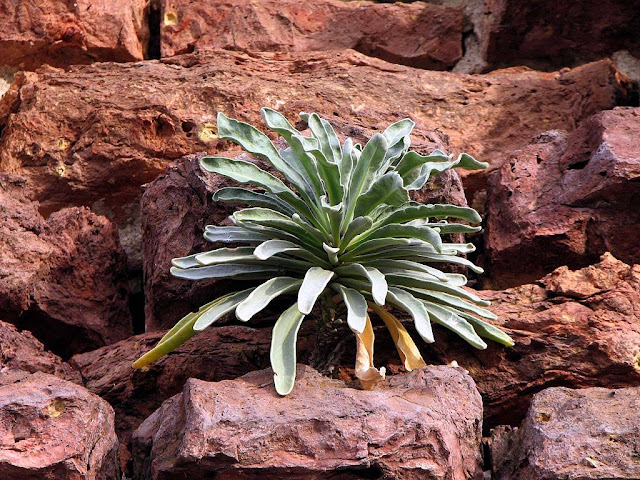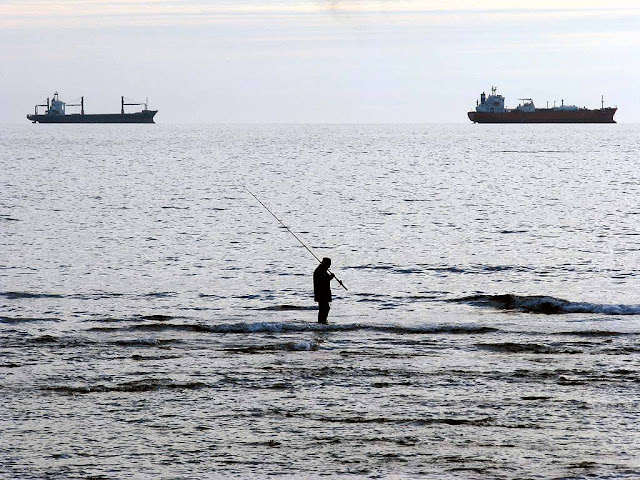 I have found these chimneys on top of a set of buildings called “Palazzi Rossi” (Red Buildings), on the corner of Viale della Libertà (Freedom Boulevard) with Viale Mameli. “Palazzo”, in contemporary Italian, has rarely anything palatial in it and is currently used for any type of building. It is also used for a palace, meaning a large and stately mansion. “Palazzi Rossi” is a residential compound built in the 1930's occupying an entire block. It was completely repainted a few years ago in the same dark red visible in the photo.
I have found these chimneys on top of a set of buildings called “Palazzi Rossi” (Red Buildings), on the corner of Viale della Libertà (Freedom Boulevard) with Viale Mameli. “Palazzo”, in contemporary Italian, has rarely anything palatial in it and is currently used for any type of building. It is also used for a palace, meaning a large and stately mansion. “Palazzi Rossi” is a residential compound built in the 1930's occupying an entire block. It was completely repainted a few years ago in the same dark red visible in the photo.
Saturday, February 28, 2009
Six Chimneys
 I have found these chimneys on top of a set of buildings called “Palazzi Rossi” (Red Buildings), on the corner of Viale della Libertà (Freedom Boulevard) with Viale Mameli. “Palazzo”, in contemporary Italian, has rarely anything palatial in it and is currently used for any type of building. It is also used for a palace, meaning a large and stately mansion. “Palazzi Rossi” is a residential compound built in the 1930's occupying an entire block. It was completely repainted a few years ago in the same dark red visible in the photo.
I have found these chimneys on top of a set of buildings called “Palazzi Rossi” (Red Buildings), on the corner of Viale della Libertà (Freedom Boulevard) with Viale Mameli. “Palazzo”, in contemporary Italian, has rarely anything palatial in it and is currently used for any type of building. It is also used for a palace, meaning a large and stately mansion. “Palazzi Rossi” is a residential compound built in the 1930's occupying an entire block. It was completely repainted a few years ago in the same dark red visible in the photo.
Friday, February 27, 2009
Window on the Harbour
 The “Porto Mediceo” seen from a window of the “Fortezza Vecchia” (Old Fortress), built by Antonio da Sangallo for the Medici in 1534. My “window” was probably an embrasure for a large gun. On the left, before the swing bridge, there is the “Darsena Vecchia” (Old Harbor) which now host the Coast Guard, the Fire Department and mainly fishing boats. On the right, you can see one of the three bastions of the fortress: this is called the “Canaviglia” and Cosimo I liked it so much to have a residence built on top of it. After the bridge is the “Porto Mediceo” proper, dominated here by the huge yellow hull of a Corsica-Sardinia ferry.
The “Porto Mediceo” seen from a window of the “Fortezza Vecchia” (Old Fortress), built by Antonio da Sangallo for the Medici in 1534. My “window” was probably an embrasure for a large gun. On the left, before the swing bridge, there is the “Darsena Vecchia” (Old Harbor) which now host the Coast Guard, the Fire Department and mainly fishing boats. On the right, you can see one of the three bastions of the fortress: this is called the “Canaviglia” and Cosimo I liked it so much to have a residence built on top of it. After the bridge is the “Porto Mediceo” proper, dominated here by the huge yellow hull of a Corsica-Sardinia ferry.Search labels: ferry
Thursday, February 26, 2009
The Tamarisk Rock
 “Scoglio della tamerice” (Tamarisk Rock) is a quiet and beautiful place on the Antignano coastline, which alternates small pebble beaches to rocky outcrops. The namesake lone tamarisk is still there on the top, telling us that no great toponymic effort was needed for this rock.
“Scoglio della tamerice” (Tamarisk Rock) is a quiet and beautiful place on the Antignano coastline, which alternates small pebble beaches to rocky outcrops. The namesake lone tamarisk is still there on the top, telling us that no great toponymic effort was needed for this rock. Enlarging this second photo you can easily spot, in the middle of the horizon line, the “Fanale dei Pisani”, marking the port of Livorno. On the same level, between two lamp posts on the right, is the pinkish top of our “grattacielo”, that appeared in yesterday's post.
Enlarging this second photo you can easily spot, in the middle of the horizon line, the “Fanale dei Pisani”, marking the port of Livorno. On the same level, between two lamp posts on the right, is the pinkish top of our “grattacielo”, that appeared in yesterday's post.Wednesday, February 25, 2009
Piazza Matteotti
 We call it “grattacielo di Piazza Matteotti” (Matteotti Square skyscraper), even if it barely qualify for the term. Technically is probably a high-rise, but it is so much taller than anything around that you can see it from everywhere.
We call it “grattacielo di Piazza Matteotti” (Matteotti Square skyscraper), even if it barely qualify for the term. Technically is probably a high-rise, but it is so much taller than anything around that you can see it from everywhere.This building by the architect Giovanni Michelucci (1891-1990) was commissioned in the second half of the 50's by the Department of the Treasury. Construction was completed in 1966. The tower rises from a five-storey base, reaching a height of 91 meters with 26 floors. The base mostly houses offices, while the tower is for residential use with eight apartments per floor.
It's no Chrysler Building, but I like it.
External links: Giovanni Michelucci (Wikipedia)
Labels:
architecture,
building,
Livorno,
square
Tuesday, February 24, 2009
Man in Black
 Seen few days ago outside an interior design studio in “Via Roma”. I think this is a quite fanciful way of advertising for their premises.
Seen few days ago outside an interior design studio in “Via Roma”. I think this is a quite fanciful way of advertising for their premises.
Monday, February 23, 2009
Pogoria
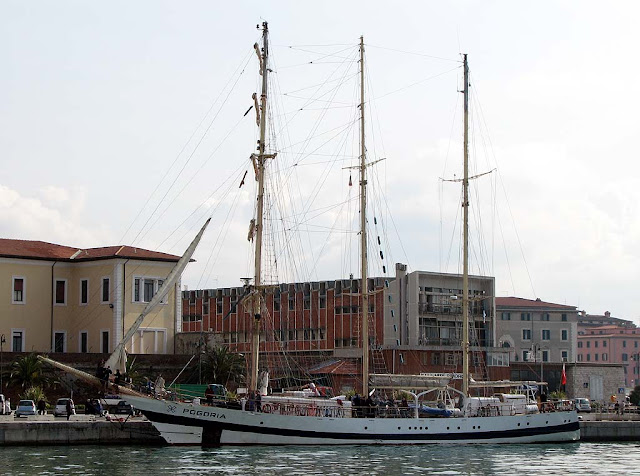 On Sunday morning I found this Polish training ship from Gdynia at the Molo Mediceo: it is the “Pogoria”, built in the Gdańsk Shipyard in 1980, during the rising years of Solidarność. Technically is a barquentine, or a sailing vessel with a square rigged foremast and fore-and-aft rigged main and mizzen masts, a rig often used nowadays for sail training on tall ships. The Pogoria, partially owned by the city of Gdynia and now based in Genoa, has an impressive record of cruises and races around the world, on lease to various organizations.
On Sunday morning I found this Polish training ship from Gdynia at the Molo Mediceo: it is the “Pogoria”, built in the Gdańsk Shipyard in 1980, during the rising years of Solidarność. Technically is a barquentine, or a sailing vessel with a square rigged foremast and fore-and-aft rigged main and mizzen masts, a rig often used nowadays for sail training on tall ships. The Pogoria, partially owned by the city of Gdynia and now based in Genoa, has an impressive record of cruises and races around the world, on lease to various organizations.See also: Welcome Back Pogoria - STS Pogoria - Goodbye, Pogoria!
Sunday, February 22, 2009
Pro-shoot-toe
 “Il prosciuttaio” is, in this case, the prosciutto sandwich vendor. I understand that this italian word for raw or dry-cured ham is now of common use in english, probably due to the diffusion abroad of Parma and San Daniele ham. In Italian we call these types “prosciutto crudo” (literally: raw, not cooked), the wet cured ham is known here as “prosciutto cotto” (literally: cooked).
“Il prosciuttaio” is, in this case, the prosciutto sandwich vendor. I understand that this italian word for raw or dry-cured ham is now of common use in english, probably due to the diffusion abroad of Parma and San Daniele ham. In Italian we call these types “prosciutto crudo” (literally: raw, not cooked), the wet cured ham is known here as “prosciutto cotto” (literally: cooked).Wikipedia says: The word prosciutto (pronounced “pro-shoot-toe”) derives from the Latin perexsuctum, which gave way to the modern Italian word “prosciugare” which means “to thoroughly dry” (lit., “[having been] very sucked out”).
Do I like prosciutto? Absolutely yes! And, as Fio rightly comments, “prosciuttaio” is “pro-shoot-teye-oh”
Saturday, February 21, 2009
John of Nepomuk
 Just on the right of Town Hall, “Via della Madonna” crosses with a bridge one of our “fossi” (canals) and reaches into the quarter of Venice. In the middle of this bridge, on its parapet, there is a statue of St John Nepomucene with a practically illegible inscription on the plinth. The Saint was placed there to honor the visit, on March 6th 1739, of Maria Theresa of Austria and Francis I, Holy Roman Emperor, as the new Grand Dukes of Tuscany.
Just on the right of Town Hall, “Via della Madonna” crosses with a bridge one of our “fossi” (canals) and reaches into the quarter of Venice. In the middle of this bridge, on its parapet, there is a statue of St John Nepomucene with a practically illegible inscription on the plinth. The Saint was placed there to honor the visit, on March 6th 1739, of Maria Theresa of Austria and Francis I, Holy Roman Emperor, as the new Grand Dukes of Tuscany.John of Nepomuk or John Nepomucene (1345-1393) is a national Saint of the Czech Republic. In 1393 he was made the vicar-general of the Archbishop of Prague. In the same year, on March 20th, he was tortured and thrown into the river Vltava from Charles Bridge in Prague at the behest of Wenceslaus, King of Bohemia. He had refused to betray the confessional secret of the Queen.
 On the basis of his martyrdom, John of Nepomuk is considered a patron against calumnies and, by the cause of his death, a protector from waters and floods. Statues of the Saint are often found on many bridges around Europe. The Saint was probably a bit absent-minded during last week flash flood here in Livorno, because in several streets the water reached knee-deep level. John of Nepomuk, obviously a modern and enterprising Saint, has an official website too: http://www.sjn.cz/eng/.
On the basis of his martyrdom, John of Nepomuk is considered a patron against calumnies and, by the cause of his death, a protector from waters and floods. Statues of the Saint are often found on many bridges around Europe. The Saint was probably a bit absent-minded during last week flash flood here in Livorno, because in several streets the water reached knee-deep level. John of Nepomuk, obviously a modern and enterprising Saint, has an official website too: http://www.sjn.cz/eng/.Friday, February 20, 2009
Window Display
 A “window display” on the first floor¹ of a building in Via Magenta: the mannequin and its “severed” head seem to wear more a costume than a dress.
A “window display” on the first floor¹ of a building in Via Magenta: the mannequin and its “severed” head seem to wear more a costume than a dress.If you follow this blog you probably already know that we have a thing for windows and shop windows and, of course, it's not finished yet!
¹ - An European first floor, so it would be an American 2nd floor.
Mistery solved:

Caprices of Carnival
Fancy dresses, costumes
and accessories for rent
First Floor
Fancy dresses, costumes
and accessories for rent
First Floor
Thursday, February 19, 2009
Eaismo
 “Eaismo” is an italian term from “Era Atomica -ismo” which probably would translate in english as “aeism” (Atomic Era -ism). It is the arcane name of an obscure artistic movement founded in Livorno in 1948 by the painter Voltolino Fontani (1920-1976) along with other local artists.
“Eaismo” is an italian term from “Era Atomica -ismo” which probably would translate in english as “aeism” (Atomic Era -ism). It is the arcane name of an obscure artistic movement founded in Livorno in 1948 by the painter Voltolino Fontani (1920-1976) along with other local artists.I have read that “Eaismo” was a forerunner of the nuclear art, of which I am absolutely not aware, in Italy and Europe.
In the photo you can see a plaque on the birthplace of the painter, in Via Sant'Andrea (St Andrew Street), which translates:
Here was born
on February, 11th 1920
the painter
Voltolino Fontani
creator of the
eaist movement
in the 30th anniversary
of his death
the Municipality of Livorno
the Labronic Group
Livorno, August, 8th 2006
on February, 11th 1920
the painter
Voltolino Fontani
creator of the
eaist movement
in the 30th anniversary
of his death
the Municipality of Livorno
the Labronic Group
Livorno, August, 8th 2006
I don't know how much “aeistic” is the plaque, but the surrounding wires and pipes are worthy of any contemporary art installation.
About nuclear art I have found only references in Italian, but you could check the bio of one of its founders, Enrico Baj, in Wikipedia and his obituary on The Guardian.
Wednesday, February 18, 2009
Gold of Pisa
 Do not be distracted by the surrounding stuff, our subject is the round yellow thing just in the middle of the photo: this is a real “teglia di torta” (pan of chickpea pie). Trillian already explained something about “torta” in a post about the “cinque e cinque”, now let's talk of history, or more probably of legends.
Do not be distracted by the surrounding stuff, our subject is the round yellow thing just in the middle of the photo: this is a real “teglia di torta” (pan of chickpea pie). Trillian already explained something about “torta” in a post about the “cinque e cinque”, now let's talk of history, or more probably of legends.One of these legends says that “torta” was created purely by chance and hunger in 1284, after Genoa defeated Pisa in the battle of Meloria, just in front of Livorno. Returning home the Genoese ships were hit by a storm and, inside the hold, overturned barrels of oil and broken sacks of chickpeas mixed with some salt water.
Being on limited supplies and notoriously parsimonious, the Genoese salvaged what they could and the sailors were served a sort of oily chickpea soup. Trying to make the dish more edible someone left it in the sun to dry, with palatable results. Derisively the sailors called it Pisa's Gold. Back to to Genoa, they greatly improved the new dish baking it in a real oven: the “farinata” or “fainé”, as they call it in Genoa, was born. The new dish was soon known all along the coast: in Pisa is now called “cecìna” and in Nice “socca”.
Variants to this legend have the Pisan prisoners from the battle discovering the magic mix, or even hungry roman legionaries left without floor concocting it centuries before.
See also: Five and five
External links: Farinata (Wikipedia)
Tuesday, February 17, 2009
Town Hall
 Our first “Palazzo Comunale” (Town Hall) built on purpose was designed by the architect Giovanni del Fantasia in 1720, sadly it had a very short life because the building was badly damaged by the earthquake of 1742.
Our first “Palazzo Comunale” (Town Hall) built on purpose was designed by the architect Giovanni del Fantasia in 1720, sadly it had a very short life because the building was badly damaged by the earthquake of 1742.It was entirely rebuilt in 1745 with the addition of the monumental double staircase by Bernardino Ciurini. The small tower at the top houses an old bell, once used to convene the Council or in other special occasions. The original construction was expanded in an adjacent building in 1867 and renovated further in 1929.
After the last war, with a wing completely destroyed by the bombings, it was partly rebuilt. The new “complex”, now joining three different buildings, was inaugurated in 1949 by the mayor Furio Diaz.
The large crest over the main door, at the top of the staircase, is better described in the post Mural Crown.
See also: Mural Crown - Piazza del Municipio - Coat of Arms
Labels:
architecture,
building,
Livorno,
town hall
Monday, February 16, 2009
Ardenza Mare
 Fairy tales villas in “Ardenza Mare” (Seaside Ardenza) along “Viale Italia”. Yes, we have also an “Ardenza Terra” (Inland Ardenza), but this is another story. “Viale Italia” goes from “Piazza Mazzini” to the “Rotonda” of Ardenza, following the coastline, passing the “Terrazza Mascagni” and the “Accademia Navale”. It has beautiful promenades, open-air bars and a few beach resorts. It was formerly known as “Viale Regina Margherita” (Queen Margherita Boulevard) changing its name in 1946, when Italy became a Republic.
Fairy tales villas in “Ardenza Mare” (Seaside Ardenza) along “Viale Italia”. Yes, we have also an “Ardenza Terra” (Inland Ardenza), but this is another story. “Viale Italia” goes from “Piazza Mazzini” to the “Rotonda” of Ardenza, following the coastline, passing the “Terrazza Mascagni” and the “Accademia Navale”. It has beautiful promenades, open-air bars and a few beach resorts. It was formerly known as “Viale Regina Margherita” (Queen Margherita Boulevard) changing its name in 1946, when Italy became a Republic.
Labels:
architecture,
Ardenza,
building,
Livorno,
villa
Sunday, February 15, 2009
Piazza Giorgio Caproni
 Yesterday a new square was dedicated to the poet Giorgio Caproni. He was born in Livorno in 1912 (the same generation of Bertolucci, Bigongiari, Gatto, Luzi, Sereni), where he lived until his family moved to Genoa when he was ten years old. The Ligurian city will become a mythical city in many of his poems. As an elementary school teacher he worked in several small towns until he moved to Rome in 1939. He fought the 2nd World War and was actively involved in the “Resistenza”.
Yesterday a new square was dedicated to the poet Giorgio Caproni. He was born in Livorno in 1912 (the same generation of Bertolucci, Bigongiari, Gatto, Luzi, Sereni), where he lived until his family moved to Genoa when he was ten years old. The Ligurian city will become a mythical city in many of his poems. As an elementary school teacher he worked in several small towns until he moved to Rome in 1939. He fought the 2nd World War and was actively involved in the “Resistenza”. His life lacked great events with the exception of the deaths of his young first love and, in 1950, of his mother. He lived a quiet life with a beloved wife, a son and a daughter, supported by a secure job as teacher.
His life lacked great events with the exception of the deaths of his young first love and, in 1950, of his mother. He lived a quiet life with a beloved wife, a son and a daughter, supported by a secure job as teacher. Caproni's poetical production has been constant, without significant gaps, with a brief silence right after the end of the war. He died in Rome in 1990.
Caproni's poetical production has been constant, without significant gaps, with a brief silence right after the end of the war. He died in Rome in 1990.External links: Giorgio Caproni (Encyclopedia Britannica) - Giorgio Caproni - Resistenza (Wikipedia)
Saturday, February 14, 2009
I Love You
 Shop window displays have to catch your eye, they often catch mine and the consequences are sometimes posted here... “Ti amo” obviously means: I love you.
Shop window displays have to catch your eye, they often catch mine and the consequences are sometimes posted here... “Ti amo” obviously means: I love you.
Friday, February 13, 2009
Nisi Serenas
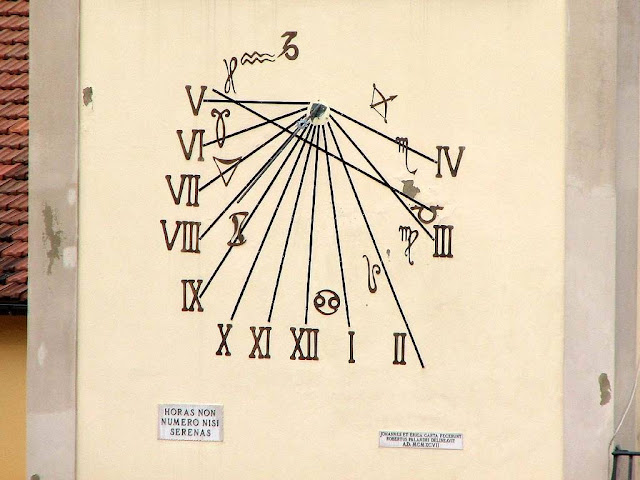 This is another sight I pass walking to work, a sundial on the bell tower of the Madonna church in “Via della Madonna”. “Horas non numero nisi serenas” is a latin motto often found on sundials and translates: I do not count the hours unless they are sunny. “Johannes et Erica Carta fecerunt - Robertus Palandri delineavit - A.D. MCMXCVII” are the Latin form of the names of the makers, the draftsman and the year of construction, 1997.
This is another sight I pass walking to work, a sundial on the bell tower of the Madonna church in “Via della Madonna”. “Horas non numero nisi serenas” is a latin motto often found on sundials and translates: I do not count the hours unless they are sunny. “Johannes et Erica Carta fecerunt - Robertus Palandri delineavit - A.D. MCMXCVII” are the Latin form of the names of the makers, the draftsman and the year of construction, 1997.
Thursday, February 12, 2009
Front Door
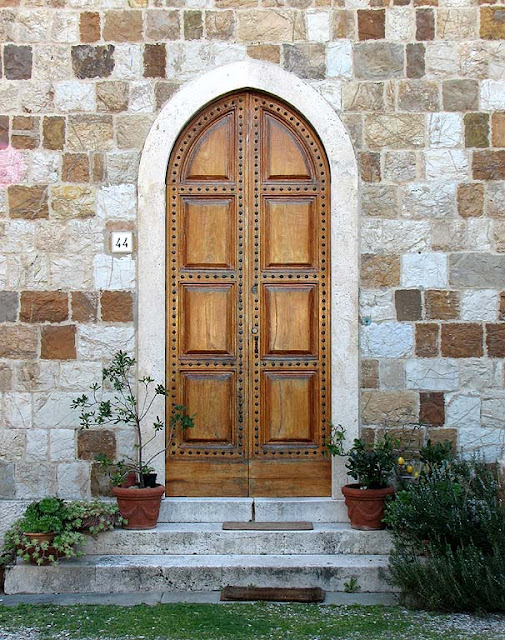 Few days ago I was enchanted by this front door in Antignano, a beautiful quarter, mostly by the sea, just on the south of Livorno.
Few days ago I was enchanted by this front door in Antignano, a beautiful quarter, mostly by the sea, just on the south of Livorno.
Wednesday, February 11, 2009
C Eaters
 As a matter of fact the Livornesi eat their Cs. It is part of a phonetic phenomenon called Tuscan gorgia which, in very simplistic terms, substitutes some Cs in a word with nothing. A phrase that still awes outsiders is the anecdotic local rendition of “Coca-Cola con la cannuccia” (Coca-Cola with a straw), which would sound something like this: “òa-òlah òla annoochah”, killing five Cs in a row. Giuseppe Mazzini (1805-1872) was a patriot and philosopher, whose efforts helped bring about the modern Italian state. Here is a bust dedicated to him by “Livorno repubblicana” (Republican Livorno) in the square carrying his name. And, as you can see, somebody ate the C of “repubblicana”.
As a matter of fact the Livornesi eat their Cs. It is part of a phonetic phenomenon called Tuscan gorgia which, in very simplistic terms, substitutes some Cs in a word with nothing. A phrase that still awes outsiders is the anecdotic local rendition of “Coca-Cola con la cannuccia” (Coca-Cola with a straw), which would sound something like this: “òa-òlah òla annoochah”, killing five Cs in a row. Giuseppe Mazzini (1805-1872) was a patriot and philosopher, whose efforts helped bring about the modern Italian state. Here is a bust dedicated to him by “Livorno repubblicana” (Republican Livorno) in the square carrying his name. And, as you can see, somebody ate the C of “repubblicana”.External links: Tuscan gorgia - Giuseppe Mazzini (Wikipedia)
Tuesday, February 10, 2009
Monday, February 9, 2009
One Hundred Years
 It's probably not far from the truth to say that these images are about a century apart. I shot this photo from “Piazza Cavour” using the old postcard as a model: you can see the same buildings, the same railings, with an addition of dumpsters, cars and boats.
It's probably not far from the truth to say that these images are about a century apart. I shot this photo from “Piazza Cavour” using the old postcard as a model: you can see the same buildings, the same railings, with an addition of dumpsters, cars and boats.
Sunday, February 8, 2009
Saturday, February 7, 2009
Leopoldine Walls
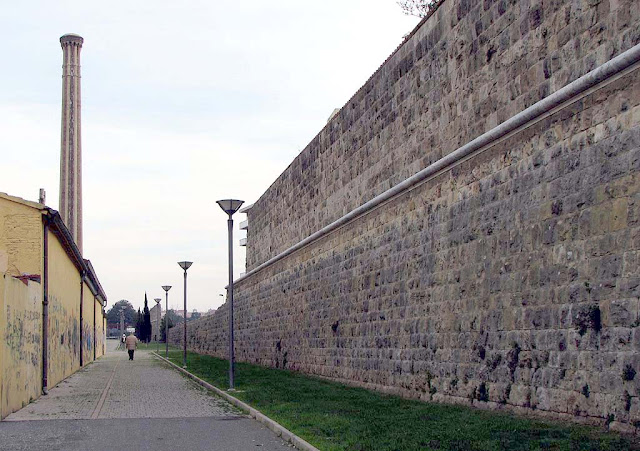 The Lorraine (or Leopoldine) Walls were built around 1830 by the architects Alessandro Manetti and Carlo Reishammer. This is one of the few tracts still standing, near the Porta San Marco (St Mark's Gate). It is clearly in better shape and cleaner than the opposite wall...
The Lorraine (or Leopoldine) Walls were built around 1830 by the architects Alessandro Manetti and Carlo Reishammer. This is one of the few tracts still standing, near the Porta San Marco (St Mark's Gate). It is clearly in better shape and cleaner than the opposite wall...Friday, February 6, 2009
Nanni's Home
 “Garage” is garage, “Nanni” is a short form for Giovanni, which is the Italian for John. So “Casa di Nanni” means Nanni's home, but I shall not reveal where in Livorno this funny plaque is.
“Garage” is garage, “Nanni” is a short form for Giovanni, which is the Italian for John. So “Casa di Nanni” means Nanni's home, but I shall not reveal where in Livorno this funny plaque is.
Thursday, February 5, 2009
Madonna Street
 I walk “Via della Madonna” (Madonna Street) everyday to work, it is a pedestrian zone, as far as a such thing can exist here: they drive slowly and don't park in the middle. This is one of the oldest street of Livorno and has two and a half churches within few meters: the half one has only the façade, the rest of the building went with the last war.
I walk “Via della Madonna” (Madonna Street) everyday to work, it is a pedestrian zone, as far as a such thing can exist here: they drive slowly and don't park in the middle. This is one of the oldest street of Livorno and has two and a half churches within few meters: the half one has only the façade, the rest of the building went with the last war.Madonna is not a very long street, but it crosses a bridge, glances at Town Hall, runs along the canals for a while, skirts the Justice Court and ends toward another major church in Venice (the quarter). Following a bout of secular eagerness, in 1901 it was renamed Giordano Bruno Street, quickly regaining its original, and more suitable, name in 1925.
 Big Deal on Madonna Street (Italian: I soliti ignoti) is a 1958 Italian criminal-comedy film, directed by Mario Monicelli, and considered to be among the masterpieces of Italian cinema. Its original title translates as “the usual unknown persons”, a journalistic an bureucratic euphemism for “unidentified criminals”. (Wikipedia)
Big Deal on Madonna Street (Italian: I soliti ignoti) is a 1958 Italian criminal-comedy film, directed by Mario Monicelli, and considered to be among the masterpieces of Italian cinema. Its original title translates as “the usual unknown persons”, a journalistic an bureucratic euphemism for “unidentified criminals”. (Wikipedia)Wednesday, February 4, 2009
Far from the Madding Crowd
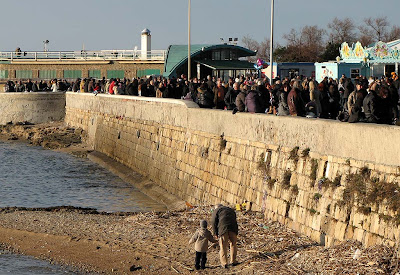 Still last Saturday at “La Rotonda”, the place of the windsurfers post by Trillian. On good weather weekends this is a quite busy promenade, more than usual this time because of the boys and the girls dressed up in funny costumes for the start of the carnival season. Below in the photo, the and the kid seem a world away from the above crowd, looking carefully at some kind of interesting flotsam in the sand.
Still last Saturday at “La Rotonda”, the place of the windsurfers post by Trillian. On good weather weekends this is a quite busy promenade, more than usual this time because of the boys and the girls dressed up in funny costumes for the start of the carnival season. Below in the photo, the and the kid seem a world away from the above crowd, looking carefully at some kind of interesting flotsam in the sand.See also: Windsurfers
Tuesday, February 3, 2009
January Sunbathing
 After two days of cold rain we still remember last Saturday, with a thought to these brave folks sunbathing on the last day of January in Antignano, Livorno.
After two days of cold rain we still remember last Saturday, with a thought to these brave folks sunbathing on the last day of January in Antignano, Livorno.
Monday, February 2, 2009
Windsurfers
 A gloriously sunny Saturday with young surfers sailing in front of “La Rotonda” (literally: the round one), a small pine grove with a nice promenade by the sea.
A gloriously sunny Saturday with young surfers sailing in front of “La Rotonda” (literally: the round one), a small pine grove with a nice promenade by the sea.See also: Going with the Wind - Three Bridges - Libeccio
Sunday, February 1, 2009
Theme Day: Paths and Passages
 They have found their path, but the passage is blocked by the glass of the shop window...
They have found their path, but the passage is blocked by the glass of the shop window...Click here to view thumbnails for all participants
Subscribe to:
Comments (Atom)


